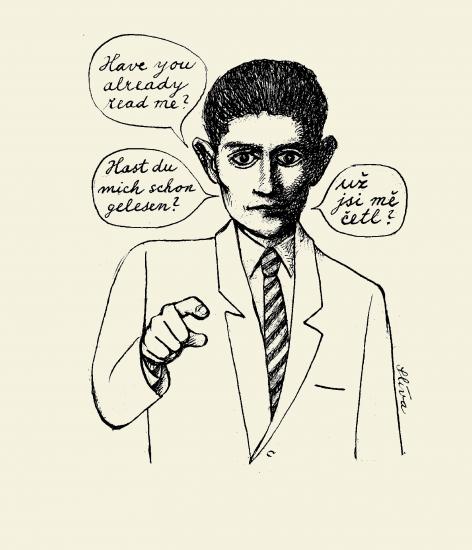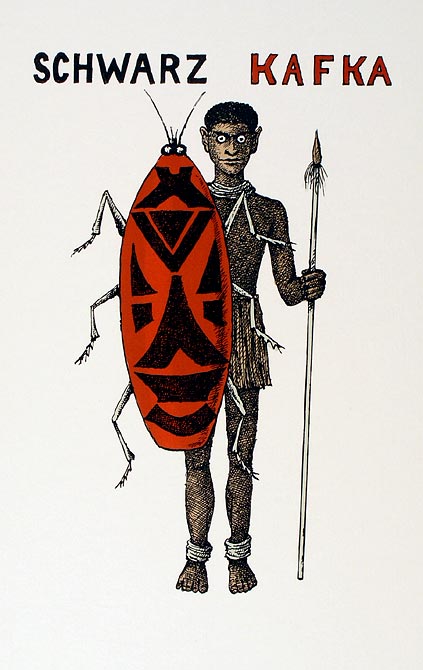Tag Archives: bauer
Crumb and Mairowitz Introducing Kafka
Introducing Kafka, also known as R. Crumb’s Kafka, is an illustrated biography of Franz Kafka by David Zane Mairowitz and Robert Crumb. The book includes comic adaptations of some of Kafka’s most famous works including The Metamorphosis, A Hunger Artist, In the Penal Colony, and The Judgment, as well as brief sketches of his three novels The Trial, The Castle, and Amerika. The book also details Kafka’s biography in a format that is part illustrated essay, part sequential comic panels. The book was released as part of the Introducing… series by Totem Books; the popularity of Crumb’s renditions of Kafka’s works led to additional printings under the title R. Crumb’s Kafka,and its most recent edition by Fantagraphics Books (2007) is simply titled Kafka.
R. Crumb’s Kafka goes far beyond being explication or popularization or survey. It’s a work of art in its own right, a very rare example of what happens when one very idiosyncratic artist absorbs another into his worldview without obliterating the individuality of the absorbed one. Crumb’s art is filled with Kafka’s insurmountable neuroses. They are all there: Gregor Samsa’s sister, the luscious Milena Jesenska, the Advacate’s “nurse” Leni, Olda and Frieda, and the ravishing Dora Diamant-drawn in that mixture of self-command, tantalizing knowingness, and sly sexuality, that amazonian randines and thick-limbed physicality that is Crumb. . . Crumb’s idiosyncratic illustrations add a new dimension to the already idiosyncratic world of Kafka.
The Czech author once wrote: “What do I have in common with the Jews? I don’t even have anything in common with myself.” Nothing could better express the essence of Franz Kafka, a man described by his friends as living behind a “glass wall.” Kafka wrote in the tradition of the great Yiddish storytellers, whose stock-in-trade was bizarre fantasy tainted with hilarity and self-abasement. What he added to this tradition was an almost unbearably expanded consciousness. Alienated from his roots, his family, his surroundings, and primarily from his own body, Kafka created a unique literary language in which to hide away, transforming himself into a cockroach, an ape, a dog, a mole or a circus artiste who starves himself to death in front of admiring crowds.
 David Zane Mairowitz and Robert Crumb
David Zane Mairowitz and Robert Crumb
David Zane Mairowitz’s brilliant text and the illustrations and comic panels of the world’s greatest cartoonist, Robert Crumb (himself no stranger to self-loathing and alienation), help us to understand the essence of Kafka and provide insight beyond the cliche “Kafkaesque,” peering through Kafka’s glass wall like no other book before it. The book is a wonderful educational tool for those unfamiliar with Kafka, including a brief but inclusive biography as well as the plots of many of his works, all illustrated by Crumb, making this newly designed edition a must-have for admirers of both Kafka and Crumb.
Kafka and Oasis in a Same Song
“You are at once both the quiet and the confusion of my heart; imagine my heartbeat when you are in this state.”
“Each of us has his own way of emerging from the underworld, mine is by writing. That’s why the only way I can keep going, if at all, is by writing, not through rest and sleep. I am far more likely to achieve peace of mind through writing than the capacity to write through peace.”
Franz Kafka
Letters to Felice
Every day I wake up and it’s Sunday
Whatever’s in my eye won’t go away
The radio is playing all the usual
And what’s a Wonderwall anyway
Because my inside is outside
My right side’s on the left side
‘Cause I’m writing to reach you now but
I might never reach you, only want to teach you
About you but that’s not you
It’s good to know that you are home for Christmas
It’s good to know that you are doing well
It’s good to know that you all know I’m hurting
It’s good to know I’m feeling not so well
Because my inside is outside
My right side’s on the left side
‘Cause I’m writing to reach you now but
I might never reach you, only want to teach you
About you but that’s not you
Do you know it’s true but that won’t do
Maybe then tomorrow will be Monday
And whatever’s in my eye should go away
But still the radio keeps playing all the usual
And what’s a Wonderwall anyway
Because my inside is outside
My right side’s on the left side
‘Cause I’m writing to reach you now but
I might never reach you, only want to teach you
About you but that’s not you
Do you know it’s true but that won’t do
And you know it’s you I’m talking to
The song was written by Fran Healy, who admitted that he took the guitar chords from Oasis‘ Wonderwall; as an overt acknowledgement of this, the song contains the lyric “and what’s a wonderwall, anyway?”. In 2004, both Writing to Reach You and Wonderwall were mixed with Green Day‘s Boulevard of Broken Dreams in the popular mash up, Boulevard of Broken Songs,Boulevard of Broken Songs by San Francisco, California DJ and producer Party Ben.
As Fran Healy stated:
“Writing To Reach You was actually inspired by Franz Kafka’s Letters To Felice. He wrote to this woman he was in love with hundreds of times, yet never met her. None of her replies are in the book, so you have to piece together their relationship. I was reading that one day, and Wonderwall came on the radio. I nicked the chords, then changed the rhythm and the melody. I’m pleased we managed to draw on Kafka and Oasis in the same song.”























